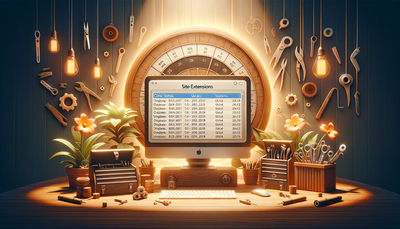Balancing Aesthetics and Functionality in Website Maintenance
In the digital age, a website serves as the face of your business or personal brand. Balancing aesthetics and functionality in website maintenance is crucial for creating a positive user experience and achieving your online goals. This article explores effective strategies for maintaining both the visual appeal and functionality of your website. We'll delve into techniques for updating designs without compromising user experience or performance, ensuring your site remains attractive, efficient, and user-friendly. By implementing these strategies, you can keep your website fresh and engaging while maintaining its core functionality and performance.Table of Contents:
-
The Importance of Balancing Aesthetics and Functionality
- Regular Design Audits and Updates
- Optimizing Performance While Enhancing Visuals
- Responsive Design and Cross-Browser Compatibility
- User-Centric Approach to Navigation and Layout
- Accessibility Considerations in Design Updates
- Continuous Testing and Iteration
- Regular Design Audits and Updates
- Optimizing Performance While Enhancing Visuals
- Responsive Design and Cross-Browser Compatibility
- User-Centric Approach to Navigation and Layout
- Accessibility Considerations in Design Updates
- Continuous Testing and Iteration

The Importance of Balancing Aesthetics and Functionality
A well-designed website should not only look visually appealing but also function smoothly. Aesthetics draw users in, creating a positive first impression and enhancing brand image. Functionality, on the other hand, ensures that users can easily navigate the site, find information, and complete desired actions. Striking the right balance between these two elements is essential for maintaining a successful website.When aesthetics and functionality work in harmony, it leads to improved user experience, increased engagement, and higher conversion rates. However, neglecting one aspect in favor of the other can result in a subpar website that fails to meet user expectations or business objectives. Therefore, website owners must prioritize both elements equally during the maintenance process.
Do you need a website? Want to build a website but don't know where to start? Our website builder is the perfect solution. Easy to use, and with the ability to customize to fit your business needs, you can have a professional website in no time.
Regular Design Audits and Updates
To maintain a visually appealing website, it's crucial to conduct regular design audits. These audits help identify outdated elements, inconsistencies, or areas that could benefit from a refresh. When updating designs, consider current design trends, but always prioritize your brand identity and target audience preferences.Implement design updates gradually to avoid overwhelming users with sudden changes. Focus on key areas such as color schemes, typography, and imagery. Ensure that new design elements align with your brand guidelines and enhance the overall user experience. By making incremental changes, you can keep your website looking fresh without disrupting the familiar layout that users have grown accustomed to.
Optimizing Performance While Enhancing Visuals
As you update your website's aesthetics, it's crucial to maintain or improve its performance. Large image files, complex animations, or excessive use of plugins can slow down your site, negatively impacting user experience and search engine rankings.To optimize performance, compress images without compromising quality, minimize the use of resource-intensive features, and leverage browser caching. Consider implementing lazy loading for images and videos to improve initial page load times. Additionally, use a content delivery network (CDN) to serve static assets quickly to users across different geographical locations. By focusing on these technical aspects, you can ensure that your website remains visually appealing without sacrificing speed and responsiveness.
Building a website with SITE123 is easy
Responsive Design and Cross-Browser Compatibility
With the increasing variety of devices used to access websites, maintaining a responsive design is crucial. Regularly test your website on different screen sizes and devices to ensure that both aesthetics and functionality remain intact across all platforms.Cross-browser compatibility is equally important. Check that your website renders correctly and functions properly on various browsers, including Chrome, Firefox, Safari, and Edge. Address any inconsistencies promptly to provide a seamless experience for all users, regardless of their chosen browser or device. By prioritizing responsiveness and compatibility, you ensure that your website's visual appeal and functionality are maintained for all visitors.
User-Centric Approach to Navigation and Layout
When updating your website's design, always keep user experience at the forefront. Maintain a logical and intuitive navigation structure that allows users to find information easily. Consider implementing breadcrumbs, clear menu labels, and a search function to enhance navigation.Analyze user behavior data and feedback to identify areas where the layout can be improved. Use heat maps and user recordings to understand how visitors interact with your site and make data-driven decisions when reorganizing content or redesigning page layouts. By adopting a user-centric approach, you can ensure that design updates enhance rather than hinder the overall user experience.
Accessibility Considerations in Design Updates
As you maintain and update your website's aesthetics, it's crucial to prioritize accessibility. Ensure that color contrasts meet WCAG guidelines, provide alternative text for images, and maintain a clear hierarchy of headings. These practices not only make your site more inclusive but also contribute to better SEO performance.Consider implementing keyboard navigation and ensuring that all interactive elements are easily operable without a mouse. Regular accessibility audits can help identify areas for improvement and ensure that your website remains usable for all visitors, including those with disabilities. By integrating accessibility into your design process, you create a more inclusive online presence while maintaining visual appeal.
Continuous Testing and Iteration
Maintaining a balance between aesthetics and functionality requires ongoing testing and iteration. Implement A/B testing for significant design changes to gauge user response and impact on key metrics. Monitor website analytics regularly to identify any negative trends in user engagement or conversion rates following design updates.Encourage user feedback through surveys or feedback forms to gain insights into how design changes are perceived. Be prepared to make adjustments based on user input and performance data. This iterative approach ensures that your website evolves in a way that continuously improves both its visual appeal and functionality, leading to better overall user satisfaction and achievement of business goals.





